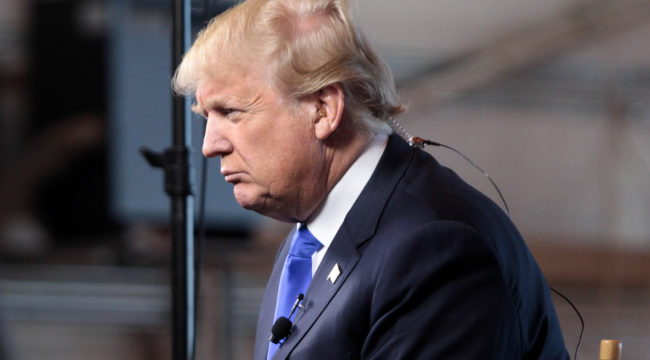Is Trump Bluffing on Tariffs?
Is Trump backing down on tariffs?
His proposal sent the Dow Jones 420 points lower last Thursday.
This weekend, the president pledged he’s “not backing down.”
How did markets react yesterday?
As if Trump will back down — or at least back off.
The Dow ended the day 337 points higher.
The S&P gained 30 points; the Nasdaq, 73.
Among the day’s biggest winners were Boeing, Harley-Davidson and Caterpillar… all potential casualties of the tariffs.
Stocks ended the day higher again today.
Why the turnaround?
The professionals think Trump left the negotiating door ajar yesterday morning when he tweeted:
Tariffs on Steel and Aluminum will only come off if new & fair NAFTA agreement is signed.
“Seeing Caterpillar and Harley-Davidson trade higher tells me that traders think this will end diplomatically,” coos Quincy Krosby, Prudential Financial’s chief market strategist.
She claims Trump’s comments showed “flexibility.”
We’re not half so sure.
It seems Trump’s “flexibility” has Canada and Mexico doing the bending.
Neither is inclined to do much, if Reuters is to be credited:
A move by Washington to link the steel and aluminum tariffs to progress on NAFTA was rebuffed by Canada and Mexico.
We don’t know.
Perhaps we are seeing the master negotiator at his tricks, the Art of the Deal taking form before us.
And maybe a compromise will follow.
But this we do know:
The next test for markets comes this Friday…
Friday is when February’s employment numbers are released.
January’s employment numbers were the supposed catalyst for last month’s spine-tingling “correction.”
They revealed an unexpected jump in average hourly earnings.
Hourly wages soared to a 2.9% annualized rate — an 8.5-year high.
That raised the specter of inflation… and aggressive rate hikes by the Federal Reserve.
New Fed Chairman Jerome Powell has in fact claimed that “inflation is moving up to target.”
Yields on the bellwether 10-year Treasury spiked… investors panicked… and stocks corrected.
Stocks uncorrected in the weeks that followed, recapturing most of their losses — until the tariff news broke last Thursday.
If Friday’s report reveals February hourly wage growth exceeds 3%, it could confirm the Fed’s inflation expectations.
And it will likely raise rates aggressively this year.
Markets could therefore sell off once again… and for the same reason they sold off last month.
MarketWatch:
“All bets are off if [the] number tops 3% — another Wall Street sell-off could be in the cards.”
Wages last increased at a 3% annual rate, MarketWatch reminds us, in 2007 — immediately prior to the Great Recession.
Why should that matter?
January unemployment also rang in at a hale and hearty 4.1%.
If February’s dips to 4% or lower… it may augur ill for the economy, oddly enough.
Nicole Smith, chief economist at Georgetown University’s Center on Education and the Workforce:
If we look historically at other times when the unemployment rate has fallen below 4%, it’s times where it was the boom phase just before recession or just after a major war period… It’s almost a precursor for a recession or a precursor for another slumping economy.
The evidence, in graphic detail:

If you’ve ever thought the Fed’s timing leaves something to be desired, here is your validation.
Jim Rickards has often warned that its planned rate hikes are sowing the seeds of the very recession it’s attempting to prevent.
Meantime, the Fed is drawing down its balance sheet… and central banks around the world are planning to withdraw “stimulus” this year.
They will almost certainly reverse course if the porridge hits the propeller, but will it be enough next time?
Maybe. Maybe not.
“It is always dawnest before the dark,” says our co-founder Bill Bonner.
With looming trade wars, rate hikes, quantitative tightening and possible recession…
Let us hope they can keep the sun in the sky for a while longer.
It could be a long night that follows…
Regards,
Brian Maher
Managing editor, The Daily Reckoning



Comments: